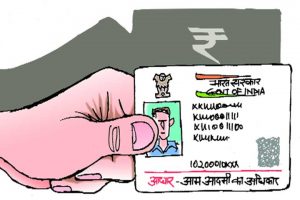
03-03-2018 (Important News Clippings)
To Download Click Here.
What Aadhaar collects
Fears of a surveillance state are overblown, but a robust privacy bill is needed.
Srikanth Nadhamuni, [The writer was founding head-of-technology of the Aadhaar project]
Claims, insinuations and even jokes have done the rounds on print and social media about how the Aadhaar system could lead to a surveillance state. There are worries that unsuspecting Aadhaar carrying residents will be closely tracked by the government while they authenticate themselves as they pay for their pizza or buy rice at a ration shop. We need to understand what data Aadhaar collects and more importantly what it doesn’t, to determine whether the above dystopian scenarios are likely or even possible.Aadhaar does only two things. First, enrolment, wherein an applicant is processed and issued an Aadhaar number. Second, online authentication where the Aadhaar holder is accurately verified during a transaction such as buying rations.
Back in December 2009, a government appointed committee with representatives from several ministries, regulators and NGOs met to determine which demographic fields should be collected to issue an Aadhaar. After lengthy deliberations, the committee came up with a simple rule – UIDAI should only collect the minimal amount of information in order to protect the privacy of the people. The four mandatory fields were, ‘Name’, ‘Address’, ‘Gender’ and ‘Date-of-birth’. ‘Email’ and ‘mobile number’ were left optional.
Similarly, a government appointed biometric committee decided that ten fingerprints, two irises, and a photo of the face were needed to accurately de-duplicate the entire population and issue a unique ID, thus ensuring that a resident does not get multiple Aadhaar IDs. This was the bane of earlier systems, where programme-based ID cards which lacked uniqueness (one person, one ID) resulted in duplicates and ghost IDs, leading to resource capture, leakage and other fraudulent transactions.Based on the above demographic and biometric data that is collected, the enrolment system issues an Aadhaar number after a de-duplication process to ensure that the resident is unique and does not already possess an Aadhaar number.
Once the resident is enrolled in the Aadhaar system, she can now authenticate herself at various points to prove her identity. Just as one would enter a user-ID and password to login to one’s email account, the Aadhaar holder can now authenticate herself by entering her Aadhaar-number (user-ID) and one of the demographic/ biometric details (password). This online verification proves to be very useful in a host of services, be it government service delivery, banking/ payments or even renting a bicycle.
Now let’s look at Aadhaar authentication.
During authentication, the user enters the Aadhaar number and one or more of the biometric (fingerprint/ iris) or demographic (name/ address/ gender/ date of birth) fields and Aadhaar returns a Yes/ No response. It does not return other details about the person, hence protecting the privacy of the individual.
The Aadhaar system does not collect the specific purpose of your authentication, or the location of your transaction so there is no way the system can construct where you were and what you were doing. As can be seen in Section 3.3 of the ‘Aadhaar Authentication API Specification’, there is no input field in the data format that collects the location or type of transaction being carried out (example, paying for your pizza or buying rice at a ration shop).Delving deeper into privacy and accountability, let’s look at the audit trail feature Aadhaar provides so that you can view your Aadhaar transactions and ensure that they were all bonafide – just as you reconcile your bank statements. It can be argued that if the history of Aadhaar transactions contained details such as what (specific transaction type), where (location information) and by whom (authenticating entity), the user would be empowered with context against potential frauds by more accountability in the system. In fact, an earlier version of the Authentication API spec did collect the location information for this very reason. On the contrary, it can also be argued that collecting the where and what and who would compromise the Aadhaar holder’s privacy.
The point i’m making is that a line has to be drawn somewhere between privacy and accountability and you can’t have both independent of each other. A measured, balanced approach between the two is in the interest of citizens and this, i believe, is what Aadhaar offers. An average smartphone user can be tracked by the telecom provider who can triangulate the user’s location through telecom base stations. Apps from Google, Facebook, Apple and thousands of other companies are also able to track smartphone user location using GPS sensors. Surveys show that over 75% of smartphone users enable location services. This is the reality of the digital world we live in. In contrast, the Aadhaar authentication system is designed to protect people’s privacy by not collecting such information.
India is coming to terms with privacy in this increasingly digital world for the first time. The debate around Aadhaar privacy is a precursor to the larger privacy debate. It is a good thing that people are becoming aware of the issues around privacy. Aadhaar brings tremendous benefits to our country, be it in plugging the leaky pipes of the government’s benefits delivery, or convenient pension payments. The passing of a robust privacy bill and Aadhaar compliance to it would hopefully help alleviate concerns as we strive to build systems of better service delivery in a data rich and digital India.
Do Not Stymie Banks With Knee-Jerk Fiats
ET Editorials
Yes, it is important for the government to be seen to be responsive to serious fraud at public sector banks, especially in the current, politically sensitive year of a series of state elections that lead up to the general elections next year. But that does not mean issuing directives to banks that are guaranteed to frighten managers into doing next to nothing at a time when the economy is showing some signs of a pick-up in investment.The directive issued to banks — to, one, examine every non-performing asset larger than Rs 50 crore for possible fraud and refer any scam identified to the CBI and, two, to identify systemic, institutional practices that would prevent fraud, both within 15 days — is designed to stymie banking for the time being rather than to sort things out.
Vigilance officers at banks are supposed to have been at work all the while and would have spotted and reported fraud, if they could spot one. Will a directive from the government give them a special scam-detecting third eye they did not possess earlier? Unlikely.Will it send panic among staff that had sanctioned loans that have soured, and will they devote all their waking moments to devising retrospective protection for themselves and plotting how to implicate some rival in a possible scam, while doing little actual banking? Very likely. And, as for creating systemic practices designed to prevent scams, it is always useful for banks to brainstorm on such a subject — but the brainstorming has to begin at the level of the government and the regulator.
Ownership and its exercise at PSBs provide room for non-professional factors to creep into loan sanctioning decisions. How should ownership/holding structures change? What role would a bond market play in vetting project viability and relieving bankers of the burden of sanctioning an inflated project loan? What lacunae prevent such a bond market from functioning? What remuneration structures would provide the right incentives for proper banking? The government and the regulator should lead the debate, not deflect it to the banks.
नियामकीय संस्थानों के लिए हो स्वतंत्र आकलन की व्यवस्था
ए के भट्टाचार्य
वित्त मंत्री अरुण जेटली ने कहा है कि भारत में राजनीतिक नेतृत्व को उसके तमाम कदमों और निष्क्रियता के लिए जवाबदेह ठहराया जाता है लेकिन नियामकों को नहीं। यह टिप्पणी लेटर ऑफ अंडरटेकिंग (एलओयू) घोटाले के संदर्भ में है जिसने पंजाब नैशनल बैंक को चपेट में ले रखा है। वित्त मंत्री के वक्तव्य के कुछ दिन पहले योजना आयोग के अंतिम उपाध्यक्ष मोंटेक सिंह आहलूवालिया ने भी देश की प्रमुख नीति निर्माण संस्थाओं में निगरानी तंत्र की कमी का जिक्र किया था। आहलूवालिया ने अपनी बात अंतरराष्ट्रीय मुद्रा कोष के स्वतंत्र आकलन के बारे में कही थी। वह इंडियन काउंसिल फॉर रिसर्च ऑन इंटरनैशनल इकनॉमिक रिलेशंस में एक संगोष्ठी को संबोधित कर रहे थे।
दोनों वक्तव्यों के संदर्भ एकदम अलग हैं। जेटली ने उक्त बयान तब दिया जब पीएनबी में हुए 114 अरब रुपये के घोटाले की खबर के बाद सरकार से जरूरी कदम उठाने की मांग की जा रही थी। आहलूवालिया की देश में नीति निर्माताओं की निगरानी की इच्छा का संबंध आईएमएफ बोर्ड द्वारा गठित स्वतंत्र आकलन कार्यालय के सकारात्मक परिणामों से है जो उसके कामकाज की निगरानी करता है। आहलूवालिया 2001 में गठित आईएमएफ के स्वतंत्र आकलन कार्यालय के पहले निदेशक भी हैं। दोनों द्वारा उठाए गए मुद्दे अहम और प्रासंगिक हैं। आखिर नियामकों को जवाबदेह कैसे बनाया जाए? क्या वित्त मंत्रालय द्वारा क्रियान्वित राजकोषीय नीतियों या एफआरबीएम ऐक्ट और मौद्रिक नीति समिति द्वारा आकलित मौद्रिक नीतियों के आकलन की निगरानी के लिए किसी निगरानी संस्था की जरूरत है? यह कहना पूरी तरह सही नहीं होगा कि भारतीय नियामक जवाबदेह नहीं हैं। फिलहाल अधिकांश नियामकों में अपीलीय संस्था है जो उनके आदेशों को देखती है और उसे यह अधिकार भी है कि चाहे तो आदेश को उलट सके। शेयर बाजार और बीमा बाजार की नियामकीय संस्थाओं के निर्णय के खिलाफ अपील की सुनवाई प्रतिभूति अपीलीय पंचाट में की जा सकती है। बिजली नियामक में एक नियामकीय संस्था है और दूरसंचार नियामक में भी। इसी तरह राष्ट्रीय कंपनी लॉ अपीलीय पंचाट में प्रतिस्पर्धा आयोग और इन्सॉल्वेंसी ऐंड बैंगक्रप्टसी बोर्ड के निर्णयों के खिलाफ अपील सुनी जाती है।
इस मामले में रिजर्व बैंक अपवाद है। उसके पास बैंकों के नियमन और मौद्रिक नीति तैयार करने जैसे दो अहम काम हैं। केंद्रीय बैंक में भी लोकपाल हैं लेकिन वे केवल बैंकों के ग्राहकों की शिकायत सुनते हैं। आरबीआई के लिए कोई अपीलीय संस्था नहीं है और उसके किसी निर्णय या बैंक नियमन को किसी उच्च प्राधिकार में चुनौती नहीं दी जा सकती है। ऐसे में वित्त मंत्री का इस बात से क्या तात्पर्य है कि भारतीय व्यवस्था के नियामक जवाबदेह नहीं हैं? आरबीआई के अलावा सभी नियामकों पर अपीलीय संस्था है जहां उनके निर्णयों को चुनौती दी जा सकती है। आरबीआई को सभी नियामकों में सर्वोच्च स्थान हासिल है। पहले से सटीक चली आ रही व्यवस्था में अचानक कोई भी बदलाव करना उचित नहीं होगा।
फिर भी नियामकों के नियमन और उन्हें जवाबदेह बनाने का सवाल काफी समय से सरकार को परेशान किए हुए है। यह भी समझा जाना चाहिए कि केवल अपीलीय संस्था बनाने से जवाबदेही तय नहीं होती। अपील संस्थान कुछ क्षेत्रों में सफल साबित होते हैं क्योंकि नियामक इस बात से अवगत होते हैं कि उनके कदमों की समीक्षा हो सकती है और उन्हें पलटा भी जा सकता है। बहरहाल, नियामकीय जवाबदेही सुनिश्चित करने का एक तरीका यह है कि सभी नियामकों या नीति निर्णय संस्थानों के लिए स्वतंत्र निगरानी संस्था बनाई जाए। उन्हें जवाबदेह बनाने के बजाय बेहतर होगा स्वतंत्र निगरानी समिति का गठन करना। यह समिति सभी नियामकीय संस्थानों और अपीलीय संस्थानों के लिए बनाई जा सकती हैं।
इन समितियों का गठन न करने के भी अनेक खतरे हैं। उनकी अनुपस्थिति में राजनीतिक प्रतिष्ठानों से नियामकों को जवाबदेह बनाने की मांग बढ़ती जाएगी। एक और खतरा मौजूदा अंकेक्षण संस्थाओं के विस्तार का हो सकता है। ये संस्थाएं संसद को इस बारे में जानकारी देती हैं कि सरकार और उसके अन्य अंग, उन्हें आवंटित संसाधनों को किस तरह व्यय कर रहे हैं। यह अपने आप में एक अहम काम है लेकिन समस्या तब खड़ी हो सकती है जब वही वित्तीय अंकेक्षक अपनी भूमिका का विस्तार करता हुआ नीतियों के औचित्य और उनके प्रभाव पर भी विचार करने लगे। नीतिगत क्रियान्वयन का आकलन करने का मानस या मानक वही नहीं हो सकता है जो वित्तीय व्यवहार और व्यय की किफायत के आकलन के।
ऐसे में यह आवश्यक है सरकार अपने राजकोषीय सुदृढ़ीकरण के लक्ष्य पर किस तरह आगे बढ़ रही है, इसके आकलन तथा वृद्घि और स्थिरता के मोर्चे पर मौद्रिक नीति समिति की सफलता जानने के लिए स्वतंत्र निगरानी संस्थानों की व्यवस्था की जाए। अहम बात यह है कि ये निगरानी संस्थाएं वित्त मंत्रालय और आरबीआई को यह सलाह भी दे सकती हैं कि उन्हें अपने लक्ष्य हासिल करने के लिए क्या कदम उठाने चाहिए। इन निगरानी संस्थानों की आजादी अहम है। तभी ये सार्थक भूमिका निभा पाएंगे। वे अपनी रिपोर्ट वित्त मंत्रालय या आरबीआई को दे सकते हैं। भले ही उनकी फंडिंग सरकार से आए लेकिन उन्हें पूरी आजादी से काम करने का मौका मिलना चाहिए। योजना आयोग ने अपने समापन से कुछ वक्त पहले स्वतंत्र आकलन कार्यालय की स्थापना की थी। परंतु योजना आयोग के साथ उसका अस्तित्व भी समाप्त हो गया। अब वक्त आ गया है कि अन्य नियामकों तथा राजकोषीय और मौद्रिक नीति के लिए स्वतंत्र आकलन कार्यालय के विचार पर काम किया जाए। देश के करदाताओं अथवा नागरिकों का यह अधिकार है।



